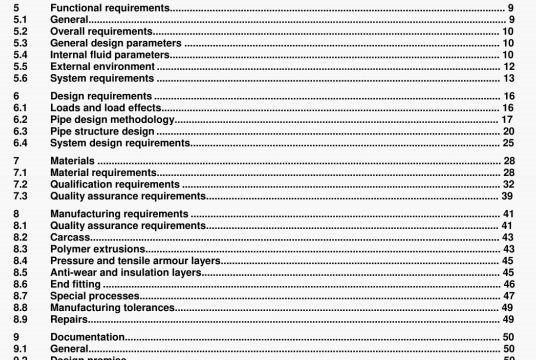BS EN ISO 13628-2 pdf download – Petroleum and natural gas industries一Design and operation of subsea production systems一 Part 2: Unbonded flexible pipe systems for subsea and marine applications.
5.6.1.7 Fire resistance
Fire resistance requirements for the pipe design should be specified, with reference to Uoyds or DNV fire test
requirements (see 6461).
5.6.1.8 Pl9gybaCk lines
Any piggyback requirements for the flexdle pipe should be specified. including details of the piggyback pipe(s) and pipe-operating conditions.
5.6.1.9 Connectors
The connector requirements for both end fittings in the flexible pipe shall be specified. This shall include, as a minimum, connector type, welding specification, seal type, and sizes.
5.6.1.10 Interface defInItions
Interface details including, but not limited to. the foNowing shall be specified:
a) regulations, codes, and standards. Including definition of code breaks:
b) geomeinc. dimensional, and lnosed loading data:
C) purchaser.supplied installation aids and equipment:
d) purchaser-supplied pull-in and connection tools and terminations:
e) manufacturer scope of supply.
5.6.1.11 InspectIon and condition monitorIng
The requirements for the manufacturer to design and implement flexible pipe inspection, monitoring, and condition assessment systems and procedures should be specified.
5.6.1.12 InstallatIon requirements
5.6.1.12.1 The purchaser should specify performance requirements for installation services to be provided, considering the following as a minimum.
a) For installation by the purchaser, he or she should specify any requirements on load restrictions, clampingensioner loads. overboarchng chute requirements. installation tolerances and port facility limitations.
b) For installation by the manufacturer, the purchaser should specify for any requirements for season. environment, vessel limitations, installation tolerances, restrictions due to conflicting activities and installation scope (induding trenching. burial, testing, inspection, surveying, and documentation).
5.6.1.12.2 The purchaser should specify any requirements for recoverability and reusability of the flexible pipe within its service life.
5.6,1.13 Exothermal chemical reaction cleaning
The purchaser should specify the relevant parameters for the pipe-cleaning operations by means of exothermal chemical reaction, considering the following as a minimum:
a) flow rate:
b) pressure variation;
C) maximum heat output:
d) chemical composition.
where stress Is the calculated stress ii the actual tayer. The stress shall be calculated using the design methodology specified in 6.2.1. subØct to the design requirements of 6.3.2. The calculated value shall include dynamic loads and be based on average stress in the layer. The average stress shaN be calculated based on distributing the total layer load uniformly over all wres in the layer. The structural capacity shall be either the yield strength. er 0,9 lImes the ultimate tensile strength of the material where tensile testing can accurately identify only this latter property. The yield or ultimate strength value used toi’ design shall be either the mean value minus two standard deviations from the documented test data or the minimum value as certified by the supier.
6.3.1.5 The utilization for the outer sheath shall be calculated based on the maximum aMowable strain. subiecl to the requirements of 6.3.2.2.
6.3.1.6 The storage minimum bend radius (MBR) shall be calculated as the rmrWmum bend radius that satisfies all the requirements of Table 6. The bend radius requied to cause locking in the interlocked layers shall be calculated. The storage MBA shall be at east 1.1 times the MBA to cause locking.
6.3.1.7 The operating MBA for static applications (all loading conditions) shall be a minimum of 1,0 limes the storage MBR. and for dynamic applications, (all loading conditions) shall be a minimum of 1,5 times the storage MBR. For dynamic applications the safety factor on operating MBR may be reduced from 1.5 to 125 for abnormal operation and normal operation with accidental loads.
6.3.1.8 Fatigue life calculations shaM be performed In accordance with the requirements of 6.3.4. The predicted fatigue life shall be at least 10 times the service life, Corrosion analysis (as specified in 6.3.4) shall show that the material loss from corrosion does nol cause utilization factors to exceed the criteria of Clause 6 under all load combinations.
6.3.1.9 Reliability-based design may be applied as an alternative design method. All relevant design criteria for the reliability based design cases should then be considered. II shall be proven that the level of safety obtained is not less than that given by this part of ISO 13628 for comparable design cases.
BS EN ISO 13628-2 pdf download – Petroleum and natural gas industries一Design and operation of subsea production systems一 Part 2: Unbonded flexible pipe systems for subsea and marine applications
